Contents
- Weather in March
- Frequently asked questions
- Average temperature in March
- Average pressure in March
- Average wind speed in March
- Average humidity in March
- Average rainfall in March
- Average rainfall days in March
- Average sea temperature in March
- Average daylight in March
- Average sunshine in March
- Average sunshine days in March
- Average UV index in March
- Average cloud cover in March
- Average visibility in March

March
Weather in March
Temperature
Entering March, the average high-temperature is recorded at a still moderate 60.4°F (15.8°C), exhibiting a minimal shift from February's 59.4°F (15.2°C). Santa Cruz's average low-temperature for the month of March records at a chilly 45.9°F (7.7°C).Humidity
March is the most humid month, with an average relative humidity of 75%.Rainfall
In Santa Cruz, in March, it is raining for 13.4 days, with typically 2.48" (63mm) of accumulated precipitation. Throughout the year, there are 77.9 rainfall days, and 14.45" (367mm) of precipitation is accumulated.Ocean temperature
In March, the average ocean temperature in Santa Cruz is 54.9°F (12.7°C).Note: Dipping in 54.9°F (12.7°C) at temperatures less than 50°F (10°C) without proper gear can lead to pronounced cold shock and breathing difficulties.
Daylight
In Santa Cruz, the average length of the day in March is 11h and 59min.On the first day of March in Santa Cruz, sunrise is at 6:37 am and sunset at 6:02 pm PST. On the last day of the month, sunrise is at 6:53 am and sunset at 7:30 pm PDT.
Note: On Sunday, March 10. 2024, at 2:00 am, Daylight Saving Time starts, and the time zone changes from PST to PDT. Daylight Saving Time lasts until Sunday, November 3. 2024, at 2:00 am; consequently, the time zone reverts from PDT to PST.
Sunshine
The average sunshine in March in Santa Cruz is 7.6h.UV index
In March, the average daily maximum UV index in Santa Cruz is 4. A UV Index value of 3 to 5 symbolizes a medium vulnerability from unsafe exposure to UV radiation for the average person.Note: An average maximum UV index of 4 in March leads to these recommendations:
Be careful. Light complexion individuals might get burns in fewer than 30 minutes. Considering the harmful UV rays from the Sun during midday, it's essential to reduce exposure. Clothes that are both tight-knit and comfortably loose are prime choices for sun protection.
Published by: Weather U.S. | About Us
Data Sources | Weather Forecasting & Climate
Frequently asked questions
What is the temperature in March in Santa Cruz?
What is the most humid month in Santa Cruz?
What is the average humidity in March in Santa Cruz?
How much does it rain in Santa Cruz in March?
How cold is the water in March in Santa Cruz?
How many hours of daylight does Santa Cruz have in March?
When are sunrise and sunset in March in Santa Cruz?
When does Daylight Saving Time (DST) start in March in Santa Cruz?
How long on average sun shines in March in Santa Cruz?
What is the UV index intensity in March in Santa Cruz?
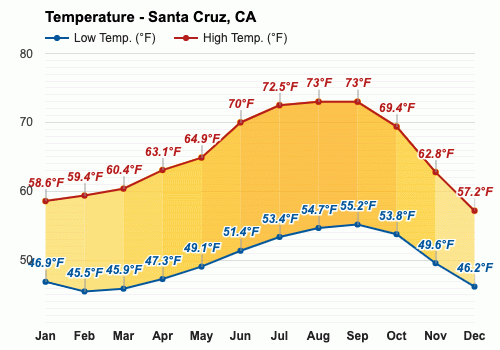
Average temperature in March
Santa Cruz, CA
- Average high temperature in March: 60.4°F
The warmest months (with the highest average high temperature) are August and September (73°F).
The month with the lowest average high temperature is December (57.2°F).
- Average low temperature in March: 45.9°F
The month with the highest average low temperature is September (55.2°F).
The coldest month (with the lowest average low temperature) is February (45.5°F).
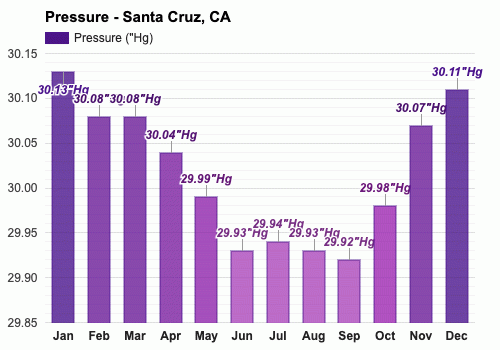
Average pressure in March
Santa Cruz, CA
- Average pressure in March: 30.08"Hg
The month with the highest atmospheric pressure is January (30.13"Hg).
The month with the lowest atmospheric pressure is September (29.92"Hg).
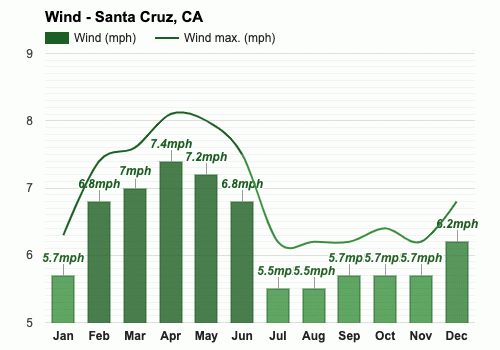
Average wind speed in March
Santa Cruz, CA
- Average wind speed in March: 7mph
The windiest month (with the highest average wind speed) is April (7.4mph).
The calmest months (with the lowest average wind speed) are July and August (5.5mph).
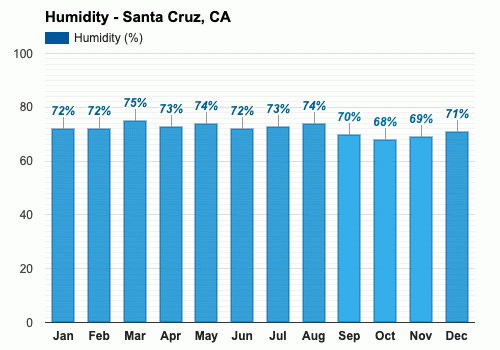
Average humidity in March
Santa Cruz, CA
- Average humidity in March: 75%
The month with the highest relative humidity is March (75%).
The month with the lowest relative humidity is October (68%).
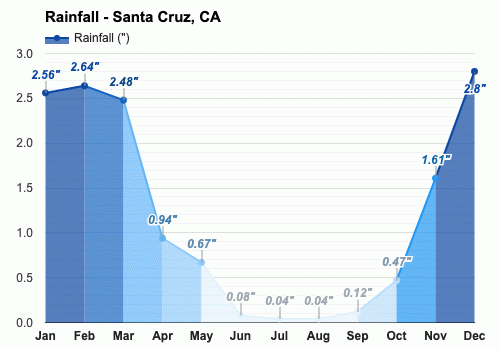
Average rainfall in March
Santa Cruz, CA
- Average rainfall in March: 2.48"
The wettest month (with the highest rainfall) is December (2.8").
The driest months (with the least rainfall) are July and August (0.04").
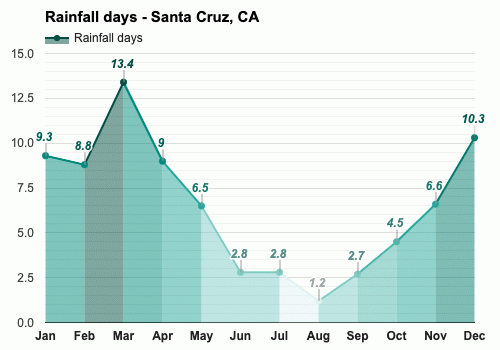
Average rainfall days in March
Santa Cruz, CA
- Average rainfall days in March: 13.4 days
The month with the highest number of rainy days is March (13.4 days).
The month with the least rainy days is August (1.2 days).
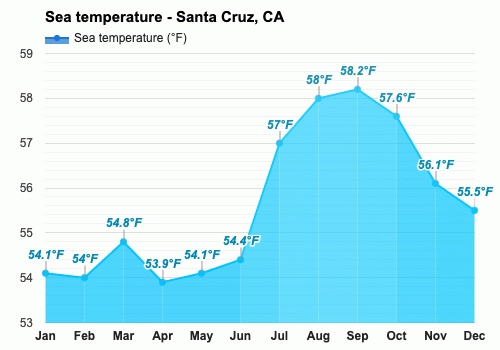
Average sea temperature in March
Santa Cruz, CA
- Average sea temperature in March: 54.8°F
The best month for swimming (with the highest average sea temperature) is September (58.2°F).
The coldest month (with the lowest average sea temperature) is April (53.9°F).
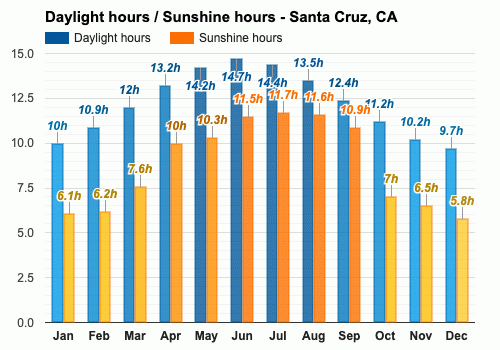
Average daylight in March /
Average sunshine in March
Santa Cruz, CA
- Average daylight in March: 12h and 0min
The month with the longest days is June (Average daylight: 14h and 42min).
The month with the shortest days is December (Average daylight: 9h and 42min).
- Average sunshine in March: 7h and 4min
The month with the most sunshine is July (Average sunshine: 11h and 42min).
The month with the least sunshine is December (Average sunshine: 5h and 48min).
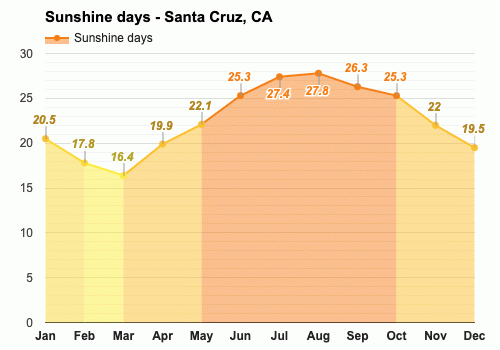
Average sunshine days in March
Santa Cruz, CA
- Average sunshine days in March: 16.4 days
The month with the most sunshine days is August (27.8 days).
The month with the least sunshine days is March (16.4 days).
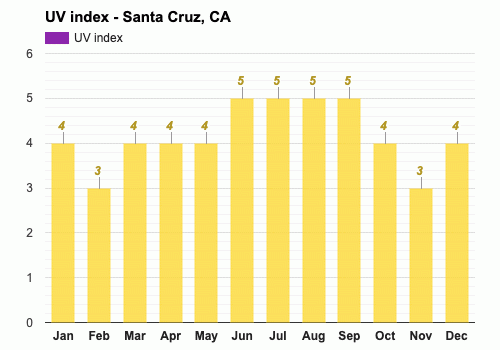
Average UV index in March
Santa Cruz, CA
- Average UV index in March: 4
The months with the highest UV index are June, July, August and September (UV index 5).
The months with the lowest UV index are February and November (UV index 3).
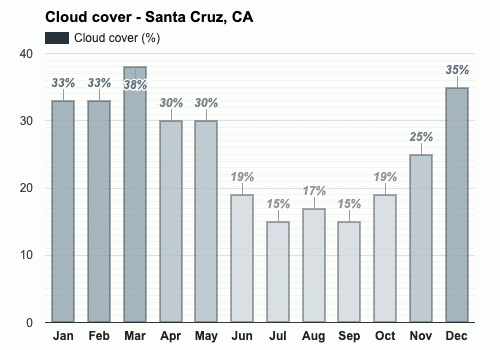
Average cloud cover in March
Santa Cruz, CA
- Average cloud cover in March: 38
The month with the most cloud cover is March (Cloud cover 38).
The months with the least cloud cover are July and September (Cloud cover 15).
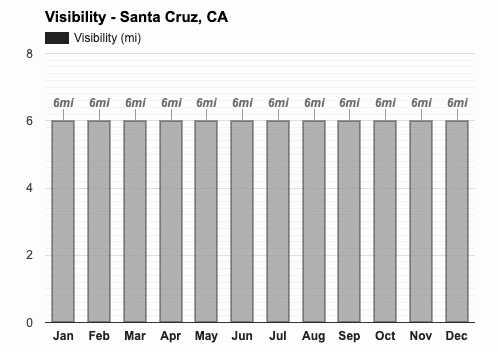
Average visibility in March
Santa Cruz, CA
- Average visibility in March: 6mi
The months with the highest visibility are January, February, March, April, May, June, July, August, September, October, November and December (6mi).
The months with the lowest visibility are January, February, March, April, May, June, July, August, September, October, November and December (6mi).